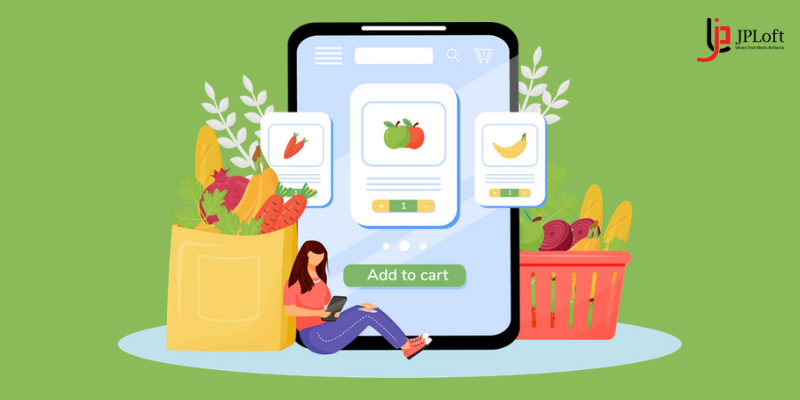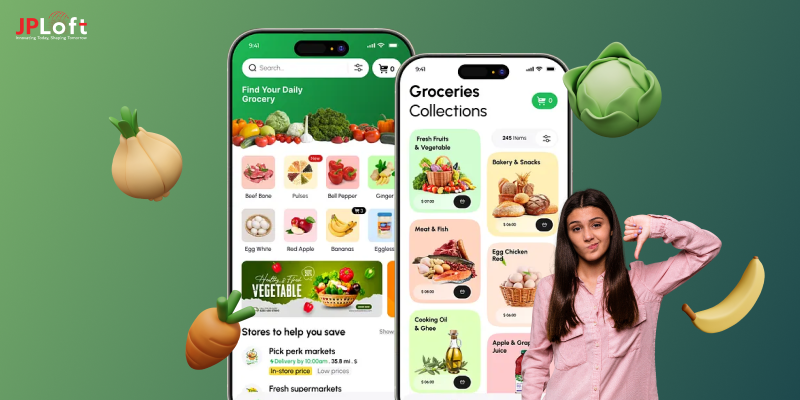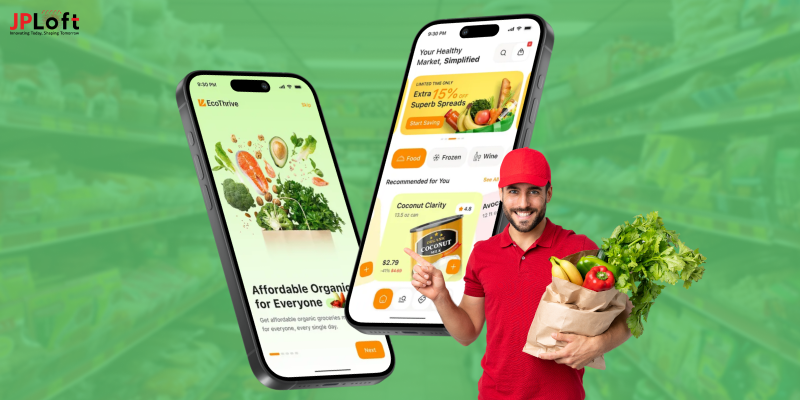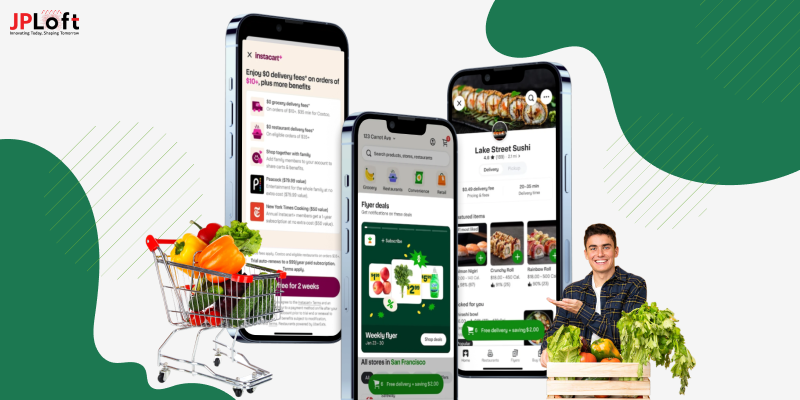The United States grocery market has changed dramatically as technology and consumer tastes have changed rapidly. This study examines the impact of Grocery Delivery Apps on American supermarkets. The convenience of Grocery Delivery Apps has quickly gained popularity. Customers can order their groceries using their smartphones, and they will be delivered to them at their door. Instacart, Amazon Fresh, and Walmart Grocery quickly became industry leaders, introducing an unprecedented level of access and efficiency to grocery shopping. As the number of mobile app development services increases, the traditional supermarkets that have been the foundation of American food since its inception are now facing a significant challenge. This blog will explore the effects of apps that deliver groceries, from their influence on customer preferences to their impact and financial viability on traditional supermarkets. Our goal in exploring the various aspects of digital disruption is to understand its present state and anticipate future trajectory as it moves between tradition and technology.
Grocery Delivery Applications are on the RISE.
The convenience of Grocery Delivery Apps has revolutionized the way people buy groceries. They offer unparalleled flexibility and ease.
Recently, apps that make shopping online more efficient are gaining in popularity, particularly since the COVID-19 outbreak, when consumers began ordering all kinds of products, from fruits and vegetables to pantry essentials, and having them delivered to their doorstep - sometimes within hours!
The success of Grocery Delivery Apps is primarily due to the consumers' busy lifestyles and reliance on technology. Time has become a valuable commodity due to busy schedules, double-income households, and increased technology use.
Apps that deliver groceries to your home, office, or on the go are a great way for people to avoid the hassle of going into stores. This shift in market dynamics has led to more retail and supermarket chains offering their delivery service, further increasing competition.
The ability to customize and personalize shopping apps has further enhanced the customer experience. Advanced algorithms suggest products that match individual preferences and previous purchases, making it easier for shoppers to find new items and stay true to their shopping lists.
The rapid growth of Grocery Delivery Apps has changed how we shop in the 21st century. They offer consumers an easy and convenient method to fulfill their shopping needs.
Types of Grocery Delivery Apps
The popularity of Grocery Delivery Apps has grown over the years. They offer consumers a convenient and easy way to buy groceries and other household items online. Below is more information about specific types of applications.
Apps for Traditional Grocery Stores
Customers of established supermarket chains can often download traditional grocery apps. The technology allows shoppers to search for products in their local store, make shopping lists, and order groceries by delivery or pickup. Users can access fresh fruits, vegetables, meat, and dairy products at affordable prices. They are often delivered to the door or available for pickup from nearby stores. The App allows users to pay for groceries and deliver them directly to their door or ready for pickup from nearby stores.
Apps for Online Marketplace
Apps that connect shoppers with multiple grocery stores or retailers are available online. They do this by combining product listings of different vendors to create a more comprehensive offer. The App allows users to compare and choose items across multiple shops. Some offer free delivery as part of their experience, while others partner with other grocery delivery app development companies to fulfill orders.
Apps for Specialized Grocery Deliveries
Some Grocery Delivery Apps are specialized in particular niches, such as organic products or gourmet foods, ethnic food, or health-related items. They may have product options tailored to specific demographics, interest groups, or markets. Additional features include meal planning or nutrition guidance for the niche market.
Delivery Apps for Meal Kits
The applications are designed to provide pre-portioned recipes and ingredients for easy meal preparation at home. They eliminate the stress of grocery shopping. Users can choose meal kits according to their dietary requirements and receive the essential ingredients and cooking instructions.
Connecting Consumers with Local Farmers and Artisans
The apps allow consumers to buy fresh produce, dairy products, meats, and other artisanal items at Farmers' Markets. The apps promote "farm to table" while promoting sustainable community agriculture.
Subscription Box Services
Subscriber box services deliver curated groceries regularly, usually in weekly or monthly packages. They may include snacks, beverages, or specialty foods. Subscribers to subscription box services receive premium grocery items delivered to their doorstep!
Alcohol Delivery Apps
Apps that deliver alcohol, such as beer, wine, and spirits, are often age-verified according to local laws. Users can choose to have their beverages delivered to their homes or picked up at a pickup location.
Convenience Store Delivery Applications
They provide customers easy access to essentials such as toiletries, snacks, drinks, and basic household items. These applications are designed to offer quick solutions for everyday products that run out or require replenishment quickly and conveniently.
Essential Features of Grocery Delivery Apps
Over time, Grocery Delivery Apps offer a variety of valuable features that are designed to make shopping easier for users and streamline the shopping process. They also provide a customized shopping experience. Here are 10 of these features in more detail.
A User-Friendly Interface
It is essential to have an app that allows for easy grocery shopping. Menu items and the search bar must be easily navigable, while visual appeal should influence your purchasing decision.
Search for Products and Filters
An efficient search engine helps to locate items quickly. Furthermore, filters and sorting options tailored towards price, brand name, dietary restrictions/preferences/allergies enhance shopping experiences - this feature being precious to vegetarians or people with food allergies.
Real-Time Inventory
It is essential to maintain real-time inventory information to provide users with the items they require. Apps should show product availability and alert users when certain items are out of stock. This will eliminate order discrepancies for the user and provide a more accurate shopping experience.
Cart management and Shopping lists
Most Grocery Delivery Apps allow users to create and manage their shopping lists easily. Shopping lists help users to organize their purchases better, save time, and reduce overbuying. They can add items to the cart and view their lists whenever needed. Budget planning and expense tracking are made simple with this feature - helping to save money as well as time by avoiding overspending.
Schedule Deliveries
Grocery Delivery Apps offer the ability to plan deliveries at times convenient for users. The user can choose between same-day or next-day delivery options, as well as weekly deliveries, to fit their schedules and daily routines. The scheduling option makes the grocery delivery app accessible, as it helps plan around hectic lives and schedules.
Payment Options
To ensure seamless checkouts, Grocery Delivery Apps must offer multiple payment options. This could be through digital wallets, credit/debit cards, or cash-on-delivery. Payment gateways that are easy to use will ensure quick checkout and a seamless shopping experience.
Customized Recommendations
Personalized recommendations can enhance shopping. Apps can recommend products or recipes relevant to you. The apps may offer additional offers.
Track orders in Real Time
The ability to track orders in real-time is a feature that customers will find invaluable. They can monitor their shipments with the estimated delivery times and locate the drivers who are delivering them. This creates greater transparency for the customer and gives him peace of mind.
Feedback and Customer Service
Customer support can be vital in meeting users' needs, solving issues promptly, and creating an enjoyable shopping experience with Grocery Delivery Apps. Additionally, users should be able to provide feedback on their experiences with Grocery Delivery Apps to improve service and quality
Discounts, Coupons and Loyalty Programmers
Apps that deliver groceries often offer incentives like coupons, discounts, and loyalty programs to keep and attract customers. These features are designed to encourage repeat purchases, which is both a marketing tool and a customer retention tool. 
Grocery Delivery Apps: The Challenges they Face over Traditional Markets
Due to their ease, Grocery Delivery Apps are gaining in popularity. However, these apps also pose unique challenges when compared with traditional markets. Here are a few of the challenges that Grocery Delivery Apps face in greater detail:
Quality Assurance
Grocery Delivery Apps are concerned with ensuring the quality and freshness of their products. They can choose their produce, meat, and other perishables themselves at traditional markets and make sure they match up with personal preferences before buying. Apps that deliver groceries rely on packers and pickers to choose products for their clients, which can lead to discrepancies in quality and customer preferences.
Shipping and Delivery Fees
Online grocery shopping is more expensive than buying groceries in stores without additional delivery charges. When operating grocery delivery app development services, it is essential to find a balance between cutting costs and maintaining profits.
Product Availability
Although Grocery Delivery Apps strive to provide a wide selection, they may only sometimes have every product available. This can be frustrating for customers who are looking for specific items or products that are difficult to find online. The traditional markets offer a more comprehensive range of products.
Delivery Times and Availability
Customers often need help finding instantaneous groceries through apps. The customer must wait until it becomes available to receive one, while traditional markets offer instant access during operating hours.
Experience a Unique Shopping Feel
Customers can enjoy a more engaging experience at traditional markets, where they interact with the staff, ask for recommendations, and inspect items before buying them. Some shoppers may find that Grocery Delivery Apps provide a different level of sensory and personal engagement than traditional markets.
Delivery Logistics
In densely populated cities, navigating delivery logistics is challenging for apps that deliver groceries. Problems including traffic congestion, unpredictable weather, and temperature-controlled transport could impede timely and safe product deliveries; traditional markets don't face these logistical hurdles.
Process for Refunds and Returns
The return and refund process for apps that deliver groceries can be complex. Returning damaged or sub-par products for a refund can be more complicated than simply replacing them in the store.
Barriers to Technology
Some customers may need more technology or knowledge to use Grocery Delivery Apps. Traditional markets are more accessible to a broader range of people who might not be tech-savvy.
Reliance on Third-Party Delivery Services
Most Grocery Delivery Apps depend on third-party delivery services for orders. This leaves the App susceptible to delays in delivery, poor-quality service, and possible personnel shortages.
Environmental Concerns
The increased traffic along delivery routes has led to higher carbon dioxide emissions and more waste during the shipping process. Traditional markets may appear less environmentally friendly because customers bring their reusable bags.
Grocery Delivery Apps Compared to Traditional Markets
Customers increasingly choose Grocery Delivery Apps because they offer many advantages over the conventional market. The following are some of the main benefits of Grocery Delivery Apps.
Convenience
Customers can enjoy convenience with Grocery Delivery Apps. The convenience of shopping from home is an excellent feature for those who have mobility problems, busy schedules, or prefer to avoid crowds.
Time-Saving
The apps that deliver groceries save users time. The traditional market can require travel, browsing, and queueing. With apps, users can select products quickly before they are delivered to their door, freeing time for leisure activities.
A Wide Range of Products
Apps that deliver groceries offer a more comprehensive selection of products than traditional stores. The App allows users to access items that are not available locally, such as unique products and specialty brands.
Shopping Made Simple
The apps simplify the user's shopping experience. They can also use filters for searching specific products and take advantage of features such as personalized recommendations or order histories. This is a streamlined and efficient solution that streamlines the experience without you missing any essential items!
Real-Time Inventory
The inventory of Grocery Delivery Apps is usually updated live. This allows users to know exactly what products are available and in stock. It also saves them the hassle of having to visit traditional stores only to find out that they need something.
Options for Delivery
The apps allow you to select the delivery time that suits you best, whether it's same-day delivery, scheduled delivery, or next-day delivery.
Contactless Shopping
Contactless options are becoming more popular due to the recent COVID-19 epidemic. The use of Grocery Delivery Apps allows customers to place orders without having direct contact with delivery staff and without a cash transaction taking place. This increases both the safety and efficiency during checkout.
Discounts, Promotions and Special Offers
Some Grocery Delivery Apps provide special discounts and promotions to help you save money on your grocery shopping. These deals can include discounts or free delivery for a certain period, or even buy one get one free or freebies on specific products.
Accessibility and Inclusion
Grocery apps allow more people to shop for groceries. They are accessible even if you live in a remote area or don't have easy access to transportation.
Environmental Benefits
Using apps that provide groceries could be a more eco-friendly alternative to traditional grocery shopping. These apps reduce carbon dioxide emissions by consolidating and optimizing delivery. These apps may reduce the carbon footprint associated with shopping.
Reduce Impulse Purchases
Grocery Delivery Apps help users stick to their lists and reduce unplanned spending by reducing impulse purchases.
Meal Planning Assistance
Meal planning is now available in many apps to help users choose healthier, more balanced foods. Apps that offer meal planning can be based on items in the user's cart. This is a great way to help plan meals and make them more balanced.
Costs of Developing Grocery Delivery Apps
An essential app for grocery delivery on iOS or Android might cost anywhere between $20,000 to $50,000, while a more advanced version could be over $100,000. Get a detailed quote tailored to your project. Costs for creating apps that deliver groceries can vary dramatically based on the project's scope. To get accurate estimates, you need to investigate each aspect of your content. The cost of developing an app for grocery delivery can vary widely depending on several factors, such as its complexity, features, and platform (iOS, Android, or both) or the geographic location where it is developed. These costs can be broken down into different components.
Hire App Development Team
The cost of your App is greatly affected by the team that develops it. The primary team comprises a project leader, designers, backend/frontend developers, quality assurance testers (QA),and quality control (QC). The cost of these teams depends on their experience and location.
App Design
Design is crucial to the overall user experience. An app that has a friendly interface will attract users and keep them. Wireframing and prototyping are usually included in app design costs, as is user experience design.
IOS or Android C
ross-platform tools can reduce the costs of building apps simultaneously for iOS and Android.
Functionality and Features
The cost to make an app depends on its complexity. From basic features like product listing and user registration to more advanced ones such as order tracking or AI-powered suggestions to AR shopping and integration with IoT devices.
Backend Development
For any business to be successful, it must have a backend infrastructure that manages data about users, products, inventory, and orders. Costs will vary depending on complexity.
Implementation of Payment Gateways
Payment processing fees, including licensing, setup, and transaction costs, are associated with secure payment gateway integration. I
ntegrations with Third Parties
If you plan to integrate third-party tools such as analytics, maps, or customer service tools in your project, there could be extra costs such as API fees and integration expenses.
Testing and Quality Assurance
Testing and QA are essential to ensure an app is secure, meets industry standards and regulations, and has a smooth and functional design. The cost of testing includes manual and automatic tests, as well as bug-fixing services.
Security Measures
It is vital to maintain the security of user data and transactions. Costs include SSL certificates, technology for encryption, and services that monitor safety continuously.
Launch and Deployment
App store registration fees, such as Apple App Store or Google Play Store fees, and compliance costs related to app store guidelines are required to prepare your App for launch.
Updates and Maintenance
Budgets should include ongoing updates and maintenance to fix bugs, improve features, and ensure compatibility with OS upgrades. Minimize costs for future maintenance and updates.
Location
Selecting developers is a matter of location - developers in lower-cost regions are more cost-effective than those in high-cost areas.
Compliance
According to your locality, regulations relating to food safety, data privacy, or delivery could require that your business adhere to specific standards about food safety, data privacy, or delivery. Compliance costs can be substantial if these requirements are not met. 
Conclusion
The grocery delivery app has undoubtedly revolutionized the supermarkets of America. These innovative technologies offer unprecedented convenience to consumers. They allow them to order groceries from their homes and deliver them to their doorstep, saving time! In times of crises, such as during the COVID-19 Pandemic, consumers prefer to shop online rather than in-person. Customers could purchase items online without having to visit a store physically. This transformation has its challenges. Traditional supermarkets need to adapt their services and investments in online shopping and delivery if they want to stay competitive. There are also concerns about data privacy and the treatment of workers that call for regulatory intervention. The grocery app market is thriving, and supermarkets that embrace innovation and technology have managed to survive and thrive with these apps. The coexistence of traditional and digital shopping has increased consumers' choices while fostering additional competition. Both sides benefit, and in the end, it is ultimately the customers who benefit. The impact of Grocery Delivery Apps on traditional supermarkets is expected to continue changing over time due to technological innovation and consumer preferences.
FAQs
1. What are Grocery Delivery Apps, and how do they work?
Grocery Delivery Apps (GDAs) are mobile apps that allow people to order groceries online, which will be delivered to them at their doorstep. GDAs offer users a wide range of options before allowing them to select the products they need before adding those to their virtual cart. The App allows users to select a delivery partner or the in-house Delivery team to deliver groceries to a specific address.
2. What are the best apps for grocery delivery?
Apps that deliver groceries are convenient for busy families and individuals—saving time and energy by eliminating physical store visits. Customers can order customized items and deliver them to their doorstep for a stress-free shopping experience!
3. Where can I find Grocery Delivery Apps near me?
Start your search for Grocery Delivery Apps in the app store of your mobile device. To determine an app's quality, you can also read customer reviews. Ask your friends and neighbors about local apps.
4. Is it safe to share payment information on Grocery Delivery Apps?
The most reputable Grocery Delivery Apps place a high priority on user security. They use encryption and payment gateways with secure payments that protect payment information. When you download an unknown app, check the privacy policies and Terms of Service. Strong passwords combined with two-factor verification offer additional security. 5. Are Grocery Delivery Apps an excellent way to schedule recurring deliveries?
Absolutely. This feature is available in many Grocery Delivery Apps. It's an excellent option for families and individuals with regular grocery requirements. This feature allows you to set up a regular delivery schedule, such as biweekly, weekly, or monthly. You can adjust as needed until the deliveries are delivered according to plan.












Share this blog